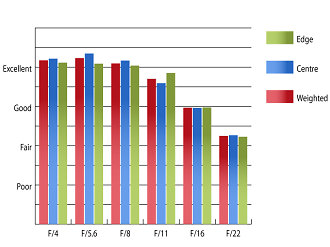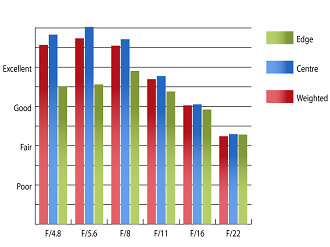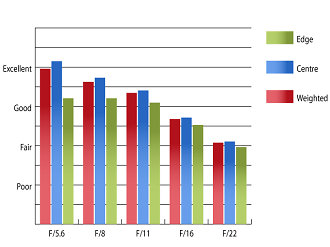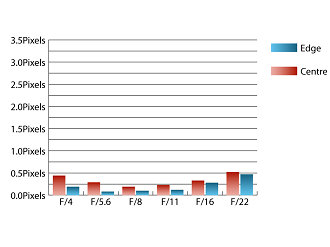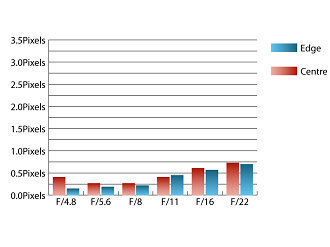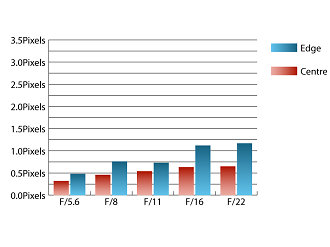Panasonic Lumix 35-100mm f/4.0-5.6 Asph Lens Review
Panasonic Lumix G Vario 35-100mm f/4.0-5.6 Asph Performance
At 35mm sharpness levels are already excellent across the frame at maximum aperture and remain this way until the lens is stopped down beyond f/8.
Zooming to 50mm results in increased sharpness in the centre of the frame, but at the expense of slightly reduced performance towards the edges of the frame. Even so, clarity is still very good towards the edges, although sharpness is outstanding in the centre of the frame at this focal length.
Finally, at 100mm peak performance is realised at maximum aperture. Here sharpness is excellent in the centre of the frame and good towards the edges.
How to read our charts
The blue column represents readings from the centre of the picture frame at the various apertures and the green is from the edges. Averaging them out gives the red weighted column.The scale on the left side is an indication of actual image resolution. The taller the column, the better the lens performance. Simple.
For this review, the lens was tested on a Panasonic Lumix GX7 using Imatest.
Chromatic aberrations are pretty well controlled throughout most of the zoom range. Unfortunately, they are no as well controlled at 100mm when shooting at the slower end of the aperture range. Here fringing exceeds a pixel width, which may become visible along high contrast edges if images are printed at large sizes, or harsh crops are taken from the edges of the frame.
How to read our charts
Chromatic aberration is the lens' inability to focus on the sensor or film all colours of visible light at the same point. Severe chromatic aberration gives a noticeable fringing or a halo effect around sharp edges within the picture. It can be cured in software.Apochromatic lenses have special lens elements (aspheric, extra-low dispersion etc) to minimize the problem, hence they usually cost more.
For this review, the lens was tested on a Panasonic Lumix GX7 using Imatest.
Falloff of illumination towards the corners is fairly typical for a lens of this type, and shouldn't pose too many issues. At 35mm and f/4 the comers are 1.75 stops darker than the centre and at 100mm, and f/5.6 falloff is reduced and the corners are only 0.804 stops darker than the image centre. Stopping down to f/8 results in visually uniform illumination throughout the zoom range.
Distortion is extremely well controlled with only 0.146% barrel distortion at 35mm being replaced with only 0.114% pincushion distortion at 100mm. This low level of distortion should rarely require correction, but if it does, the distortion pattern is uniform across the frame throughout the zoom range, which should make applying corrections in image editing software afterwards, relatively straightforward.
A petal shaped hood is supplied, which does an excellent job of shielding the lens from extraneous light that may cause issues with flare. Contrast remains good when shooting into the light also.
Value For Money
Priced at £300 at launch, this lens represents decent enough value for money, especially when the excellent performance and compact, retractable design are taken into account.
There aren't really any other close equivalents available to compare against, although the raft of 40-150mm lenses available from Panasonic and Olympus may also be considered by someone buying this lens, especially as those lenses offer more telephoto reach, for less money, having prices ranging from £140 to £180.
Add your message
Please login here or if you've not registered, you can register here. Registering is safe, quick and free.
photodo Stats
428 MTF tests
74 in-depth photodo reviews
100+ users join each day
Help the lens community by reviewing or rating a lens today via our lens search
Latest Lens Reviews
- Chinon 28mm f/2.8 Vintage Lens Review
- Canon EF 70-200mm f/4L IS II USM Lens Review
- Samyang AF 85mm f/1.4 EF Review
- Sigma 70mm f/2.8 DG Macro Art Review
- Samyang AF 24mm f/2.8 FE Review
- Meike 50mm f/1.7 Review
- Tamron 70-210mm f/4 Di VC USD Review
- Lensbaby Burnside 35mm f/2.8 Review
- Asahi Super Takumar 50mm f/1.4 Review
- Asahi Super-Multi-Coated Takumar 135mm f/3.5 Review
